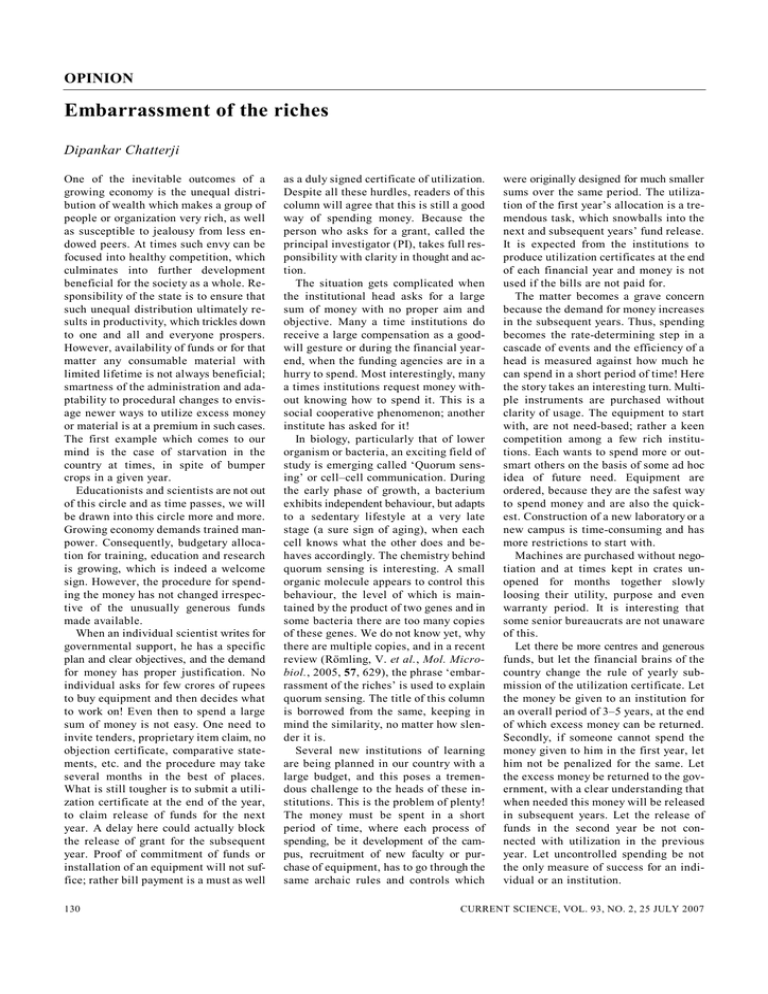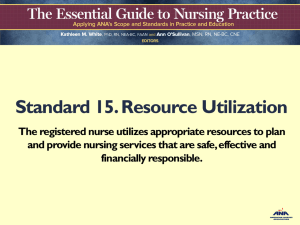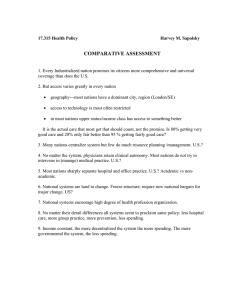Embarrassment of the riches OPINION
advertisement

OPINION Embarrassment of the riches Dipankar Chatterji One of the inevitable outcomes of a growing economy is the unequal distribution of wealth which makes a group of people or organization very rich, as well as susceptible to jealousy from less endowed peers. At times such envy can be focused into healthy competition, which culminates into further development beneficial for the society as a whole. Responsibility of the state is to ensure that such unequal distribution ultimately results in productivity, which trickles down to one and all and everyone prospers. However, availability of funds or for that matter any consumable material with limited lifetime is not always beneficial; smartness of the administration and adaptability to procedural changes to envisage newer ways to utilize excess money or material is at a premium in such cases. The first example which comes to our mind is the case of starvation in the country at times, in spite of bumper crops in a given year. Educationists and scientists are not out of this circle and as time passes, we will be drawn into this circle more and more. Growing economy demands trained manpower. Consequently, budgetary allocation for training, education and research is growing, which is indeed a welcome sign. However, the procedure for spending the money has not changed irrespective of the unusually generous funds made available. When an individual scientist writes for governmental support, he has a specific plan and clear objectives, and the demand for money has proper justification. No individual asks for few crores of rupees to buy equipment and then decides what to work on! Even then to spend a large sum of money is not easy. One need to invite tenders, proprietary item claim, no objection certificate, comparative statements, etc. and the procedure may take several months in the best of places. What is still tougher is to submit a utilization certificate at the end of the year, to claim release of funds for the next year. A delay here could actually block the release of grant for the subsequent year. Proof of commitment of funds or installation of an equipment will not suffice; rather bill payment is a must as well 130 as a duly signed certificate of utilization. Despite all these hurdles, readers of this column will agree that this is still a good way of spending money. Because the person who asks for a grant, called the principal investigator (PI), takes full responsibility with clarity in thought and action. The situation gets complicated when the institutional head asks for a large sum of money with no proper aim and objective. Many a time institutions do receive a large compensation as a goodwill gesture or during the financial yearend, when the funding agencies are in a hurry to spend. Most interestingly, many a times institutions request money without knowing how to spend it. This is a social cooperative phenomenon; another institute has asked for it! In biology, particularly that of lower organism or bacteria, an exciting field of study is emerging called ‘Quorum sensing’ or cell–cell communication. During the early phase of growth, a bacterium exhibits independent behaviour, but adapts to a sedentary lifestyle at a very late stage (a sure sign of aging), when each cell knows what the other does and behaves accordingly. The chemistry behind quorum sensing is interesting. A small organic molecule appears to control this behaviour, the level of which is maintained by the product of two genes and in some bacteria there are too many copies of these genes. We do not know yet, why there are multiple copies, and in a recent review (Römling, V. et al., Mol. Microbiol., 2005, 57, 629), the phrase ‘embarrassment of the riches’ is used to explain quorum sensing. The title of this column is borrowed from the same, keeping in mind the similarity, no matter how slender it is. Several new institutions of learning are being planned in our country with a large budget, and this poses a tremendous challenge to the heads of these institutions. This is the problem of plenty! The money must be spent in a short period of time, where each process of spending, be it development of the campus, recruitment of new faculty or purchase of equipment, has to go through the same archaic rules and controls which were originally designed for much smaller sums over the same period. The utilization of the first year’s allocation is a tremendous task, which snowballs into the next and subsequent years’ fund release. It is expected from the institutions to produce utilization certificates at the end of each financial year and money is not used if the bills are not paid for. The matter becomes a grave concern because the demand for money increases in the subsequent years. Thus, spending becomes the rate-determining step in a cascade of events and the efficiency of a head is measured against how much he can spend in a short period of time! Here the story takes an interesting turn. Multiple instruments are purchased without clarity of usage. The equipment to start with, are not need-based; rather a keen competition among a few rich institutions. Each wants to spend more or outsmart others on the basis of some ad hoc idea of future need. Equipment are ordered, because they are the safest way to spend money and are also the quickest. Construction of a new laboratory or a new campus is time-consuming and has more restrictions to start with. Machines are purchased without negotiation and at times kept in crates unopened for months together slowly loosing their utility, purpose and even warranty period. It is interesting that some senior bureaucrats are not unaware of this. Let there be more centres and generous funds, but let the financial brains of the country change the rule of yearly submission of the utilization certificate. Let the money be given to an institution for an overall period of 3–5 years, at the end of which excess money can be returned. Secondly, if someone cannot spend the money given to him in the first year, let him not be penalized for the same. Let the excess money be returned to the government, with a clear understanding that when needed this money will be released in subsequent years. Let the release of funds in the second year be not connected with utilization in the previous year. Let uncontrolled spending be not the only measure of success for an individual or an institution. CURRENT SCIENCE, VOL. 93, NO. 2, 25 JULY 2007 OPINION I have not seen the development of science in the West or Japan. I have worked and visited institutions which had been established much before. However, I have seen intimately the development of the Institute of Biomedical Sciences, Academica Sinica in Taiwan (ROC) and the development of institutions in South Korea. They follow a pattern. Construction of campus, a modern one, and recruitment of scientists at the international level go hand in hand over a period of 2–3 years. Scientists are given enough time to relocate. During the interim period their job from a distance is to hire students, assistants, plan and purchase of equipment and design of the laboratory space. The end-point of the whole process is the actual joining of the faculty in person, by which time work in the laboratory is already started by the students and post-docs with guid- CURRENT SCIENCE, VOL. 93, NO. 2, 25 JULY 2007 ance from the faculty during frequent visits or from a distance. It appears to me that we are in a hurry to spend. Are we embarrassed of our riches? Dipankar Chatterji is in the Molecular Biophysics Unit, Indian Institute of Science, Bangalore 560 012, India e-mail: dipankar@mbu.iisc.ernet.in 131



